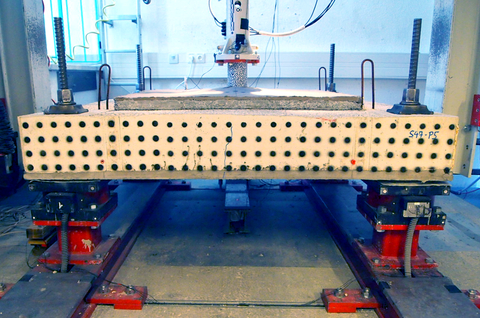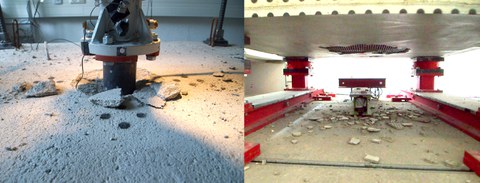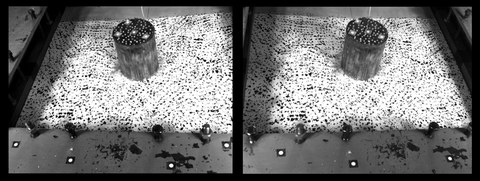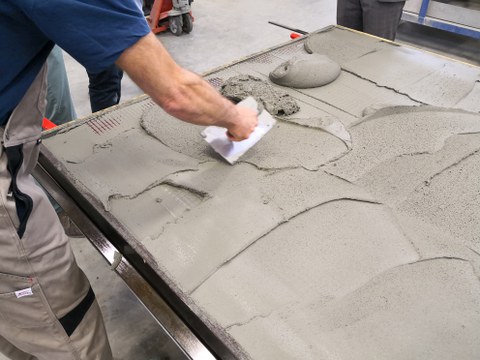Verstärkung bügelbewehrter Platten gegen Impakt
Inhaltsverzeichnis
Projektdaten
| Titel | Title Promotionsprojekt A5/II: Verstärkung auf der Rückseite von flachen, bügelverstärkten Massivbauelementen gegen Impakt als Teilprojekt des GRK 2250 | Doctoral projekt A5/II: Strengthening on the rear side of flat, stirrup reinforced solid construction elements against impact as part of RTG 2250 Förderer | Funding Deutsche Forschungsgemeinschaft (DFG) / GRK 2250 Zeitraum | Period 05/2020 – 04/2023 (2. Kohorte | 2nd cohort) Leitung | Project managers Prof. Dr.-Ing. Dr.-Ing. E.h. Manfred Curbach, Dr.-Ing. Birgit Beckmann Bearbeiter | Contributor |
Bericht aus dem Jahrbuch 2023
Verstärkung auf beiden Seiten

Impaktversuch auf Platte mit Dämpfungssystem an der Oberseite und rückseitiger Verstärkungsschicht
In der Regel weisen bestehende Konstruktionen aus Stahlbeton lediglich einen begrenzten Widerstand gegenüber stoßartigen Belastungen auf. Das Graduiertenkolleg (GRK) 2250 „Mineral-bonded composites for enhanced structural impact safety” widmet sich daher intensiv der Erforschung und Optimierung des Bauteilverhaltens unter Impaktbelastungen.
In den ersten beiden Kohorten des Promotionsprojekts A5 stand die Erforschung von dünnen, rückseitig aufgetragenen Verstärkungsschichten aus mineralischen Kompositen auf Stahlbetonplatten sowohl mit als auch ohne Querkraftbewehrung im Vordergrund. In der aktuellen dritten Kohorte wird dies durch die Betrachtung einer vorderseitig applizierten mineralisch gebundenen Dämpfungsschicht ergänzt. Münden soll diese Forschung in einem Ingenieurmodell, welches das Verhalten derart verstärkter Stahlbetonplatten beschreibt.
Zum Ende der zweiten Kohorte wurde eine finale Testserie zur Zusammenführung der Forschungen mehrerer Promotionsprojekte des GRK in der Fallturmanlage des Instituts durchgeführt. Hierzu wurden sowohl Probekörper mit unterseitig appliziertem Carbonbeton (Thema in A5/I und II) oder einer oberseitig aufgebrachten Dämpfungsschicht (Thema von Projekt A6/II) als auch Platten mit einer Kombination aus beidem geprüft. Dabei zeigte sich, dass das im Projekt A6/II entwickelte mehrschichtige Dämpfungssystem effektiv die in den Probekörper eingebrachte Impaktbelastung minderte und oberseitige Abplatzungen vollständig verhinderte. Das Lösen von rückseitigen Bruchstücken konnte ebenfalls reduziert werden. In dieser Hinsicht zeigten die rückseitigen Verstärkungsschichten ihre Leistungsfähigkeit, da diese durch ihre Membranwirkung das Herauslösen von Bruchstücken vollständig verhindern konnten. Eine Kombination beider positiver Effekte führte zu einer wesentlichen Reduktion der Plattenschädigung im getesteten Geschwindigkeitsbereich und einem erfolgreichen Abschluss der Arbeiten der zweiten Kohorte.
In der dritten Kohorte wird das System der beidseitig verstärkten Platten anhand eines Dreimassenschwingers betrachtet. Dabei beschreiben die einzelnen Federn das globale Biegeverhalten, das lokale Stanzverhalten sowie die (gedämpfte) Einwirkung des Impaktors. Das Verhalten des vereinfachten dynamischen Modells soll anhand von Versuchen verifiziert und verbessert werden.
Bericht aus dem Jahrbuch 2022
Verstärkung sei Dank, Perforation gebannt

Oberseite (links) und Unterseite (rechts) einer im Fallturm getesteten Platte
Bestehende Konstruktionen aus Stahlbeton verfügen in der Regel nur über einen geringen Widerstand bei stoßartigen Beanspruchungen. Im Rahmen des Graduiertenkollegs (GRK) 2250 „Mineral-bonded composites for enhanced structural impact safety“ wird daher an der Verbesserung des Bauteilverhaltes unter Impakt gearbeitet. Im Promotionsprojekt A5 stehen dabei dünne, rückseitig applizierte Verstärkungsschichten aus mineralisch gebundenen Kompositen im Mittelpunkt der Forschung, deren prinzipielle Wirkungsweise bereits innerhalb der ersten Kohorte des GRK erarbeitet wurde. In der aktuell laufenden zweiten Kohorte liegt das Hauptaugenmerk vor allem auf der Quantifizierung der erzielten Widerstandssteigerung.
Zuerst erfolgte hierfür die Untersuchung unverstärkter Stahlbetonplatten mit verschiedenen Impaktgeschwindigkeiten. Die Intensität wurde dabei so gewählt, dass neben dem Rückprall des Impaktors als Anzeichen eines hauptsächlich globalen Tragverhaltens des Probekörpers auch das Perforieren der Platte durch den Impaktor als Indikator für das Überschreiten der lokalen Tragfähigkeit auftrat. Dabei erfolgten die experimentelle Untersuchung verschiedener Biege- und Bügelbewehrungskonfigurationen innerhalb der Probekörper sowie die Charakterisierung des Perforationsverhaltens über die Bestimmung der Durchschussgeschwindigkeiten. Anhand der bis dato durchgeführten Tests zeigte sich, dass bei zusätzlicher Verwendung gut verankerter Bügel die Perforationsgrenze um mindestens 12 % gesteigert werden konnte.
Im zweiten Teil des Projekts wurden Platten mit einer rückseitigen Verstärkungsschicht aus 2 cm Carbonbeton hergestellt, wobei eine Matrix aus Feinkornbeton sowie zwei kreuzweise einlaminierte Carbontextilien zum Einsatz kamen. Die damit beschichteten Platten wurden ebenfalls mit verschiedenen Intensitäten bis zum Eintreten des Perforationsschadens getestet. Aus den bisherigen Ergebnissen verstärkter Platten ohne Schubbewehrung ist ebenfalls eine Steigerung des Durchschusswiderstandes um mindestens 12 % zu erkennen. Hieraus lässt sich ableiten, dass eine fehlende oder zu gering ausgeführte Schubbewehrung durch Aufbringen einer rückseitigen Carbonbetonschicht ausgeglichen werden kann.
Bericht aus dem Jahrbuch 2021
Membranwirkung gegen Perforation

Stereoaufnahme eines kleinformatigen Impakttests zur Materialcharakterisierung
Als Folge stetig steigender Gefahren von natürlich bzw. menschlich verursachten Katastrophenfällen besteht ein weltweites Interesse, die Impaktsicherheit von Baukonstruktionen zu erhöhen. Einen vielversprechenden Ansatz stellt die Verstärkung der betreffenden Bauteile unter Verwendung von mineralisch gebundenen Kompositen dar. Entsprechende Materialkombinationen werden aktuell im Rahmen des Graduiertenkollegs 2250 „Mineral-bonded composites for enhanced structural impact safety“ erforscht und weiterentwickelt. Eine zentrale Rolle nimmt in diesem Zusammenhang die Wirkungsweise auf Bauteilebene ein, deren Analyse Gegenstand des Promotionsprojekts A5 ist.
Im Rahmen der ersten Kohorte des GRK 2250 wurden dazu bereits biegebewehrte Stahlbetonplatten durch Auftragen einer Schicht aus Carbonbeton bzw. aus einer hochfesten Polymerfaserbetonmatrix (strain hardening cementitious composite, SHCC) auf der impaktabgewandten Bauteilseite verstärkt. Es zeigte sich, dass durch die ausgeprägte Membranwirkung der zusätzlichen Verstärkungsschichten eine Erhöhung des Perforationswiderstands erzielt werden konnte.
An diesen Arbeitsstand anknüpfend wird aktuell im Rahmen der zweiten Kohorte an der Erweiterung des Versuchsprogramms gearbeitet. Neben der systematischen Untersuchung der bereits verwendeten biegebewehrten Platten, werden nun zusätzlich auch Grundplatten mit Bügelbewehrung getestet. Durch die experimentelle Abbildung unterschiedlicher Schädigungsgrade soll die bereits vorhandene Schädigungsbeschreibung weiterentwickelt sowie eine quantitative Evaluation der Perforationsgrenzenverschiebung vorgenommen werden. Aus den bisherigen Arbeiten zur Bruchkörperanalyse konnte bereits ein möglicher Zusammenhang zwischen dem Schädigungszustand der Grundplatte und der Leistungsfähigkeit der im späteren Projektverlauf applizierten Verstärkungsschichten abgeleitet werden. Eine zentrale Rolle nehmen dabei die Größe des Durchstanzwinkels sowie die Ausprägung des unterseitigen Schädigungsbereichs ein.
Bei der Auswertung einer Vielzahl anderer Impaktversuche auf Bauteilebene konnten in einer Literaturstudie verschiedene Einflussfaktoren auf diese Kennwerte festgestellt werden. Mit Kollegiaten anderer Fachrichtungen finden weiterhin Charakterisierungen der Verstärkungsmaterialien mithilfe von kleinformatigen Impaktversuchen statt.
Bericht aus dem Jahrbuch 2020
Carbonbeton und hybride Verstärkung gegen Impakt

Verstärkungsarbeiten einer Stahlbetonplatte für einen Impaktversuch
Im Rahmen der ersten Kohorte des Graduiertenkollegs 2250 (GRK2250/1) wurden nachträglich applizierte Verstärkungsschichten aus Carbonbeton sowie Carbongelege in einer hochfesten Polymerfaserbetonmatrix (SHCC – strain hardening cement composite) auf der impaktabgewandten Bauteilseite verwendet. Beide Verstärkungsschichten zeigten eine sehr gute Wirkung, indem sie den Perforationswiderstand der Stahl-betonplatte deutlich erhöhten. Auch die Bauteilsteifigkeit konnte durch die applizierten Verstärkungsschichten gesteigert werden.
Im Rahmen der bisher durchgeführten Untersuchungen wurden zu verstärkende Stahlbetonplatten betrachtet, bei denen ausschließlich Biegebewehrung verbaut wurde. Anhand dieser Probekörper sowie einer Handvoll Referenzplatten aus Stahlbeton wurde mit der Entwicklung einer Schädigungsbeschreibung begonnen, mit der es möglich ist, die durch eine Impakteinwirkung entstandene Bauteilschädigung zu quantifizieren. Darüber hinaus wurde an der Weiterentwicklung eines bestehenden Ingenieurmodells zur Abbildung von Impaktereignissen auf Stahlbetonbauteile gearbeitet. Hierbei handelt es sich um ein vereinfachtes mechanisches Ersatzmodell aus Massen, Federn und Dämpfern, welches um die Komponente der Verstärkungsschicht erweitert wurde. Als Basis konnte hierzu auf die experimentellen Ergebnisse sowie eigene numerische Simulationsdaten zurückgegriffen werden.
Die vertiefte Betrachtung und systematische Erweiterung dieser gewonnenen Erkenntnisse stehen im Mittelpunkt der Arbeiten im Rahmen der zweiten Kohorte des Graduiertenkollegs 2250. Ein Untersuchungsschwerpunkt liegt dabei auf der Fragestellung, inwieweit der Perforationswiderstand explizit durch eine nachträglich aufgebrachte Verstärkungsschicht gesteigert werden kann, nachdem bisher lediglich eine qualitative Steigerung festgestellt werden konnte. Neben der Verstärkung biegebewehrter
Stahlbetonplatten wird das experimentelle Versuchsprogramm auch systematisch um
Grundplatten mit zusätzlicher Bügelbewehrung erweitert. Wie in der vorangegangenen
Kohorte wird neben Carbonbeton ebenfalls eine hybride Verstärkungsschicht, bestehend
aus einem Carbongelege und einer SHCC-Matrix, eingesetzt. Abschließend erfolgt die Ergänzung und Validierung der vorhandenen Schädigungsbeschreibung sowie des Ingenieurmodells, insbesondere im Hinblick auf die zusätzliche Bügelwirkung.
